| History of Exeter
|
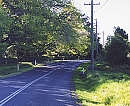 |
Exeter is the most "English" of all the villages of the Highlands, Its leafy streets and lanes, its clipped hedges and grand rows of trees give the impression of an age old-village in the "old country". In fact Exeter is one of the newer villages in the Southern Highlands, and owes its existence - as do many others - to the coming of the railway in the late 1860s. |
|
Settlement, however, preceded the development of the village by almost half a century. When Charles Throsby of Bong Bong fame opened up the area in the 1820s, many settlers prevailed upon the governor of the day for grants in the 'Sutton Forest' area. Some of these were established landholders closer to Sydney looking for wider spaces to graze their herds. One such was James Badgery, who had arrived in Sydney in 1799, and for 20 years had successfully farmed in the Bringelly region. His farm here was called 'Exeter', after the town in England near where he grew up. This name was later to be given over half a century later to the new village. |  Original store - now homestead, east of station |
Badgery was granted land between the present Sutton Forest and Exeter villages, and he and his family were later to consolidate holdings of several thousands of acres, centred on the main holding, which was called Vine Lodge.
Today a reminder of this past can be seen on the right hand side of the road as you enter Exeter from Sutton Forest - the horse stud farm of the same name. Descendants of the Badgery family still live in the area.
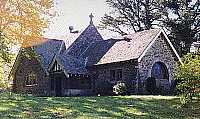 St. Aidans Anglican Church 1896 |
Other landholders also took up grants in the area, and the actual village today sits mostly on land previously owned by the Badgerys. Exeter owes its existence largely to the coming of the railway. Sutton Forest, an established village, was like Berrima bypassed further to the east by the new rail line. The new line in fact cut through the middle of the Badgery properties, and probably had the effect here and elsewhere of breaking up these older landholdings. There is evidence that some land in the area had been alienated to the railways, and this - in conjunction with the encampment of hundreds of railroad workers from time to time no doubt stimulated ideas of settlement. |
However it seems almost 20 years passed before moves were made to establish a town. In 1891 a large section of 'Vine Lodge' was subdivided and sold; the first school was also opened, and a post office. Some houses already existed for staff at the station and new lots were snapped up.
| By 1894 there was a new store (thought to be the house "Elouera" on the eastern side of the railway), and a bakery. The foundation stone of St. Aidans was also laid in 1894, and after a a public subscription the church was opened in 1896. As it was too small for the local congregation, extensions were added in 1903. By this stage the population was large enough to warrant the establishment of a School of Arts. These places were a cross between meeting hall, library, and educational institution. Exeter's distinctive mock-Tudor building was opened in 1902 on land apparently donated by Dalgety & Co., the pastoral company. |
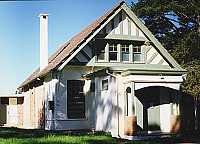 |
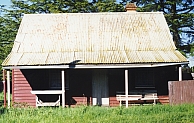 |
The old cottage seen today near the railway was originally a blacksmith's shop, and dates from 1890. The two main shops at the crossroads were built c.1900 (the current general store) and c.1920 (for many years the general store, now an antique shop). There does not seem to have been an inn or hotel in Exeter, which makes it different from most settlements in the Highlands. A gold mine operated east of Exeter at the headwaters of Stonequarry Creek in the 1880s, and a mining lease was taken out again for the area in 1904. |
But it was not gold which led to the boom in Exeter. Rather it was the availability of subdivided farming land, and the establishment of a seed raising venture by Arthur Yates in 1891. The Yates nursery, and Searl's, who joined them later, once provided all the seed stock for nurseries in the state.
Yates had nurseries on both sides of the railway line (around about where Invergowrie is today), and Searl's also on the western side.
| It is no doubt due to the influence of these two great businesses that the appearance of Exeter is what it is today. The gardens at the nurseries provided inspiration for others, and the wide range of European deciduous trees they propagated were planted profusely around the village. These gardens, trees and hedges have now matured, and give Exeter the very English appearance it has today. |
 Now Village Pump Antiques. |
Exeter continued to prosper into the 20th century. Like most towns its sons went away to war in 1914-18, and a Soldier's Memorial Hall was erected in memory of the fallen behind St. Aidan's in 1922.
From 1918 and for some years later, the former Searl's nursery was used as a convalescent home for returned soldiers by the Red Cross - the result of a generous bequest by those who had previously purchased it.
Electricity came to Exeter in 1929. By this time, so had the motor car, and from this time onwards development of the village retracted as it became easier for people to travel to the larger towns for their basic supplies.
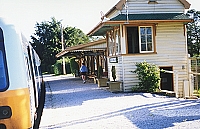 |
By the middle of this century the main industry was beef and dairy cattle, and village services shrank to the basic general store, post office, church, and school. Even railway trafiic suffered the onslaught of the motor car, and the station became just a whistle-stop on the main south line. (In comparison, a photo of the station in the 1920s shows the station full of people - compare our picture of today!) There are several reminders in Exeter today of the past and present. The extravagant School of Arts testifies to a past in which the community prided itself on its social cohesion and intelligent outlook on life. |
| The fiercely proud little white building of the Country Women's Association next to it (1955) attests to the solidarity of its country women. And a bit further down the road, a non-descript little portable building houses the modern automatic telephone exchange - one of the first in the Highlands. In recent years residential subdivisions have opened up in Exeter, but they do not as yet threaten the beauty and tranquility of the area. |
 |
Today Exeter is still a magnet for tourists who find their way here off the beaten track. There is not a lot here to do: except perhaps to wonder at and soak up the atmosphere of the very English streets and lanes; gaze in awe at the hedges and gardens of 'Invergowrie', one of the grandest homes in the Highlands; or browse around the antique, or the rare book shop.
 |
But if you are looking for peace and tranquility, there are a couple of places here where you can stay...perhaps walk around the village lanes, enjoy the quiet, and go out to visit the other attractions of the Highlands. However long you spend in Exeter, you will not forget your visit to this very beautiful corner of the Highlands. |